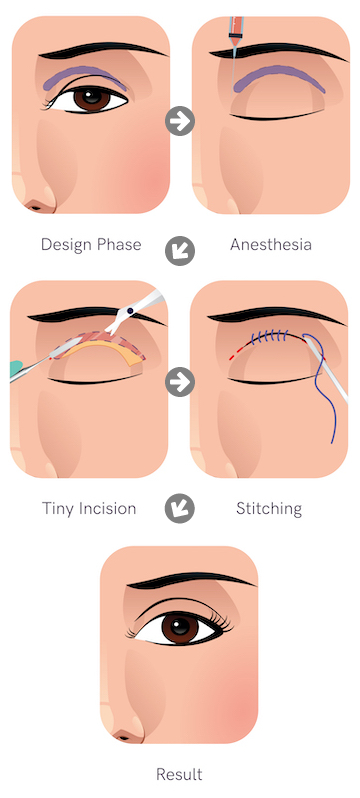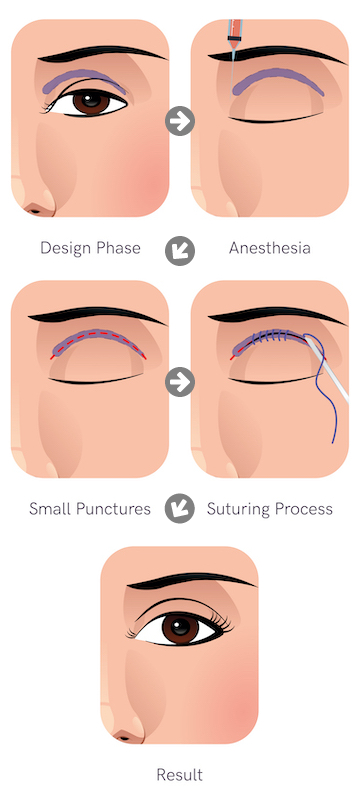Double Eyelid Surgery in Korea
Double eyelid surgery in Korea is a highly sought-after cosmetic procedure designed to create a visible crease in the upper eyelid, resulting in a “double eyelid.” In this comprehensive article, we will delve into what double eyelid surgery involves and why individuals choose to undergo this procedure. We will explore the various types of double eyelid surgeries available in Korea, including the incisional and non-incisional methods. We will provide detailed information on how to prepare for double eyelid surgery in Korea, including the initial consultation process, essential steps for pre-surgery preparation, and the role of a medical tourism agency like Shin Medical in facilitating the journey.
Furthermore, you will learn what to expect before, during, and after the surgery, including the surgical setting, anesthesia options, and post-operative care. Lastly, we will discuss the anticipated results, the longevity of the outcomes, and the importance of monitoring for potential complications to ensure a satisfying surgical experience.
Contents
What is Double Eyelid Surgery?
Double eyelid surgery, also known as Asian blepharoplasty, is a popular cosmetic procedure designed to create a visible crease in the upper eyelid, resulting in a “double eyelid.” This procedure can enhance the eye’s appearance, making them look larger and more defined. It can be performed using various techniques, including incisional, non-incisional (suture method), or a combination of both, depending on the patient’s needs and preferences.
1. Why Get Double Eyelid Surgery?
Double eyelid surgery is often sought for both aesthetic and functional reasons. Among the most common motivations for pursuing this procedure are:
- Aesthetic Enhancement: Many individuals opt for double eyelid surgery to achieve a more youthful and alert appearance. The added crease can make the eyes look larger and more symmetrical, which is often culturally desirable.
- Improved Makeup Application: A defined crease can make applying eye makeup easier and more effective. The additional space on the eyelid provides a better canvas for eyeshadows, eyeliners, and other cosmetics.
- Cultural and Social Factors: In some cultures, particularly in East Asia, having double eyelids is often viewed as a beauty standard. Achieving this feature can enhance self-esteem and social interactions.
- Functional Improvement: For some individuals, double eyelid surgery can alleviate issues such as eyelid heaviness or obstruction of vision caused by drooping skin.
2. Limitations of Double Eyelid Surgery
While double eyelid surgery can offer numerous benefits, it is important to recognize its limitations and what it cannot correct:
- Does Not Change Eye Shape: The surgery is designed to add a crease to the upper eyelid but does not significantly alter the overall shape or size of the eyes themselves.
- Limited Address of Ptosis: If a patient has ptosis (drooping of the upper eyelid due to muscle weakness), double eyelid surgery alone may not fully correct this issue. Additional procedures, such as ptosis correction surgery, may be required.
- Temporary Results: The results of the non-incisional method are generally less permanent compared to the incisional method. Over time, the stitches used in the non-incisional technique may loosen, potentially diminishing the crease.
- Not a Substitute for Blepharoplasty: While double eyelid surgery can make the eyes look bigger and more defined, it does not address issues such as excess skin, fat, or muscle in the eyelids. For these concerns, a more comprehensive blepharoplasty may be necessary.
Understanding the procedure and its limitations is crucial for anyone considering double eyelid surgery. Consulting with a qualified plastic surgeon can provide personalized insights into what this surgery can realistically achieve based on individual anatomy and goals.
Types of Double Eyelid Surgery in Korea
1. Incisional Double Eyelid Surgery
A line will be carefully measured and marked out on the eyelid. After administering anesthesia, the surgeon will make tiny incisions along the double eyelid line. Some skin, muscle, and fat tissue will be removed between the incisions. Then, the cuts will be glued or stitched. This is the preferable technique if you have thick skin and desire a more permanent result.

A line will be carefully measured and marked out on the eyelid. After administering anesthesia, the surgeon will make tiny incisions along the double eyelid line. Some skin, muscle, and fat tissue will be removed between the incisions. Then, the cuts will be glued or stitched. This is the preferable technique if you have thick skin and desire a more permanent result.

2. Non-incisional Double Eyelid Surgery
A double eyelid can also be created without an incision. In this case, as with the incisional procedure, the eyelid will be meticulously measured and marked out on the eyelid. After this, a group of tiny punctures are made along the line of the skin. Sutures are placed through the punctures and tightened until they form the desired fold. The sutures will remain hidden beneath the skin. The non-incisional technique is a good alternative for those who need a small amount of skin and fat removed, or desire a more temporary procedure.


How To Prepare for Double Eyelid Surgery in Korea
Preparing for double eyelid surgery in Korea involves several crucial steps to ensure a smooth and successful experience. Here’s a detailed overview of the preparation process:
1. Initial Consultation with a Plastic Surgeon
Finding the Right Clinic: Begin by researching and selecting a reputable clinic with experienced plastic surgeons. A medical tourism agency like Shin Medical can be incredibly helpful in identifying top-rated clinics and scheduling consultations. Their expertise can ensure you find a reputable establishment that fits your needs and preferences.
Consultation: The initial consultation typically involves discussing your aesthetic goals and medical history. This is a critical step where you can express your desired outcomes and ask any questions you might have. The surgeon will evaluate your eyelids, taking into account factors like skin type, eyelid structure, and your overall health, to recommend the best surgical method for your needs.
Medical History and Examination: It’s essential to provide a comprehensive medical history, including any previous surgeries, allergies, and current medications. This information is crucial for identifying any potential risks or complications. During this stage, the surgeon may also perform a physical examination to assess the health and structure of your eyelids. This helps in tailoring the procedure to suit your individual anatomy.
Medication Review: Your surgeon will review your current medications and advise you on any that should be discontinued or adjusted in the weeks leading up to the surgery, particularly blood-thinning medications. This step is vital to minimize the risk of excessive bleeding and other complications during and after the procedure.
Setting Expectations: This is a crucial part of the consultation where your surgeon will explain what the double eyelid surgery can and cannot achieve. Setting realistic expectations is essential for your satisfaction with the results. Your surgeon will provide a detailed explanation of the procedure, recovery process, and potential outcomes, ensuring you understand the limitations and benefits of the surgery.
Surgery Time
Eye surgery takes around 1-2 hours.
Hospital Stay
You do not need to stay in the hospital after surgery.
Days in South Korea
We suggest you stay at least 8 days after surgery.
Recovery
It takes 1 to 2 weeks to recover from eye surgery.
2. Pre-Surgery Preparation
- Specific Instructions: Follow any specific pre-surgery instructions provided by your surgeon. This may include avoiding certain medications, supplements, and foods that can increase bleeding.
- Lifestyle Adjustments: You may be advised to stop smoking and limit alcohol consumption, as these can impact healing.
- Arrange for Recovery: Plan for your post-surgery recovery period. This includes arranging for transportation to and from the clinic and ensuring you have ample time to rest and heal.
- Support System: It’s a good idea to have a family member or friend accompany you, especially if you are traveling from abroad. They can help you navigate Korea and provide support during your recovery.
3. Partnering with Shin Medical
Shin Medical can facilitate a seamless experience by assisting with:
- Consultations: Setting up consultations with highly qualified surgeons.
- Clinic Selection: Helping you find the best clinic based on your personal preferences and medical needs.
- Translation Services: Providing translation services to ensure clear communication with your healthcare providers.
- Logistical Support: Arranging accommodations and transportation, making your medical journey stress-free.
What to Expect from the Double Eyelid Surgery
Understanding what to expect before, during, and after the procedure can help alleviate anxiety and prepare you for a smooth experience.
The procedure is typically performed in an outpatient surgical facility or hospital, providing a comfortable environment for you to prepare. Depending on the technique and your comfort level, the surgeon may use local anesthesia with sedation or general anesthesia. The type of anesthesia is chosen to ensure you are as comfortable and pain-free as possible during the surgery.
If the incisional method is employed, the surgeon will make a small incision along the eyelid line, removing excess fat and skin to create a natural-looking crease. Alternatively, the non-incisional method involves making small punctures in the eyelid and inserting sutures to form the desired crease without a full incision. In some cases, a combination of both techniques may be used to achieve the best results, offering a balance between minimal invasiveness and effective outcomes.
Post-operative symptoms may include swelling, bruising, and mild discomfort, which are normal and typically subside within a week or two. It is crucial to follow the aftercare instructions meticulously; this includes keeping the incision clean, using prescribed eye drops or ointments, and avoiding strenuous activities to promote healing. Regular follow-up appointments should be scheduled with your surgeon to monitor your recovery and ensure the best outcome. During the recovery period, rest as much as possible, keep your head elevated to reduce swelling, and apply cold compresses as advised to aid in healing and comfort.
Procedure Results
After the initial recovery period, you’ll begin to notice the definitive results of your double eyelid surgery. The crease should look natural and enhance the overall appearance of your eyes.
- Final Outcome: The final results can take several months to be fully visible as swelling completely subsides and the eyelids settle into their new shape.
- Longevity of Results: While the results of the incisional method are generally permanent, the non-incisional method may require touch-ups in the future.
- Monitoring for Complications: Stay vigilant for any potential complications such as infection, asymmetry, or issues with the suture. Immediate consultation with your surgeon is advised if any concerns arise.
By carefully preparing for your surgery and understanding what to expect throughout the process, you can enhance your surgical experience and achieve satisfying results. Always consult with a qualified plastic surgeon and consider using a trusted medical tourism agency like Shin Medical to assist with logistics and language barriers.







